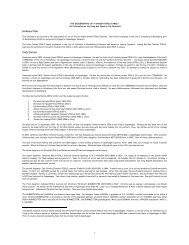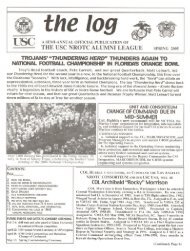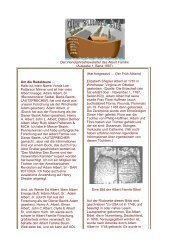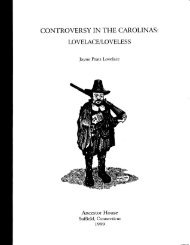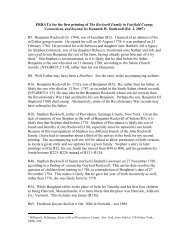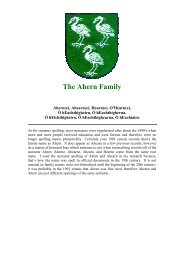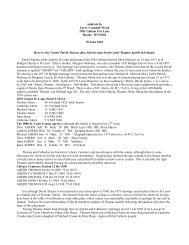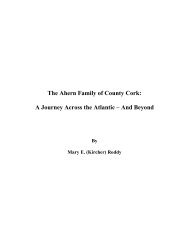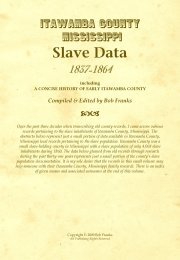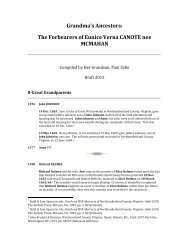The Davenport Descendants of Thomas of Evington - Homepages ...
The Davenport Descendants of Thomas of Evington - Homepages ...
The Davenport Descendants of Thomas of Evington - Homepages ...
You also want an ePaper? Increase the reach of your titles
YUMPU automatically turns print PDFs into web optimized ePapers that Google loves.
Introduction<br />
<strong>Thomas</strong> <strong>Davenport</strong>, a gentleman, was buried at <strong>Evington</strong>, Leicestershire, on 11<br />
September 1768 aged 54. He was a great grandson <strong>of</strong> <strong>Thomas</strong> the second son <strong>of</strong><br />
Richard <strong>Davenport</strong> (c 1545 – 1623/4) <strong>of</strong> Great Wigston, a nearby village. Though we<br />
know little <strong>of</strong> his life, from the researches <strong>of</strong> Jo Smallbon and one <strong>of</strong> his descendants,<br />
Michael <strong>Davenport</strong>, we know a great deal about his descendants down to the present<br />
day. What we do know <strong>of</strong> <strong>Thomas</strong> and his social milieu is given in a history <strong>of</strong> his son<br />
Samuel and his descendants, <strong>The</strong> <strong>Descendants</strong> <strong>of</strong> Samuel <strong>Davenport</strong>, Covering the<br />
years 1760 – 1954, written by Michael and posted on the <strong>Davenport</strong> family website 1 .<br />
<strong>The</strong> following pages list all <strong>Thomas</strong>’s descendants in the male line for four generations,<br />
thus matching a book listing many other descendants <strong>of</strong> Richard <strong>of</strong> Wigston, including<br />
those between himself and <strong>Thomas</strong>; it too is posted on the <strong>Davenport</strong> website. In due<br />
course the two will be combined in a new composite edition.<br />
- ** -<br />
<strong>Thomas</strong>'s sons Charles, Samuel, and Edward went <strong>of</strong>f to London to find their fortune -<br />
possibly influenced by the presence there as freemen <strong>of</strong> <strong>Thomas</strong>’s cousin William (No.<br />
257 in the book <strong>of</strong> Richard <strong>of</strong> Wigston’s descendants) and his son Burrage, a<br />
silversmith. <strong>The</strong>y prospered in their endeavours, no doubt propelled by the nonconformist<br />
religion which touched many early members <strong>of</strong> the family to a greater or<br />
lesser extent. Samuel and Edward both became extremely wealthy as silversmiths in<br />
the City - pieces <strong>of</strong> their work are still in existence and come on the market from time<br />
to time. Samuel’s wealth was such that his descendants had private incomes until the<br />
line came to an end with the death <strong>of</strong> an unmarried son in 1954. <strong>The</strong> story <strong>of</strong> his family<br />
is told in Michael’s book mentioned above. Edward, who had no children, founded a<br />
chapel in the family village <strong>of</strong> <strong>Evington</strong> with several other close family members –<br />
which still exists - when he returned there as a rich man.<br />
Charles’s success as a mill owner and businessman to the west <strong>of</strong> London was less<br />
spectacular financially but far more successful in founding a stable and well-to-do<br />
family with many descendants. Some chose to look for greener pastures and<br />
established branches in the United States, Australia and, particularly, Canada so that<br />
there are now flourishing <strong>Davenport</strong> clans in all these places.<br />
<strong>The</strong> family is, for the most part, an interesting study <strong>of</strong> the Victorian and Edwardian<br />
pr<strong>of</strong>essional classes. <strong>The</strong>ir wealth allowed their descendants access to education and<br />
the pr<strong>of</strong>essions and there are any number <strong>of</strong> solicitors and surgeons among them. A<br />
few stood out above the crowd: John Thistlewood was a prominent pharmaceutical<br />
chemist and became rich as the manufacturer <strong>of</strong> chlorodyne; he founded a dynasty<br />
which continues to this day. Another bright light, though an ephemeral one, was<br />
Edward Gershom. At first a promising engineer, he used his inherited wealth to retire<br />
at the age <strong>of</strong> 36 and stand for and get elected to the House <strong>of</strong> Commons, only to die a<br />
few months later <strong>of</strong> meningitis. Culture was not entirely absent either - several family<br />
members published their works, and one – Edward Vivian – worked at the centre <strong>of</strong> the<br />
London cultural world.<br />
1 http://homepages.rootsweb.ancestry.com/~nvjack/davnport/index.htm<br />
5



